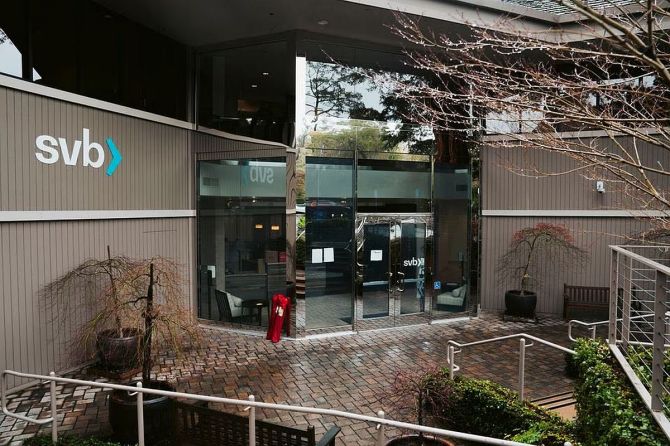 | « Back to article | Print this article |
The recent run on the US-based Silicon Valley Bank (SVB) and the subsequent seizure of its assets by the regulators may have sparked a global wave of risk aversion, particularly for start-ups.

However, the Indian banking sector is unlikely to be a victim of any contagion effects, said analysts.
he bank, which played a big role in financing start-ups and technology players, faced stress after incurring huge losses on its holdings of US bonds, following the most-aggressive monetary tightening cycle by the Federal Reserve in around four decades.
From a domestic point of view, Indian banks have minimal exposure to the beleaguered US lender.
Also, the financial sector, as a whole, is on a stronger footing following years of bad-loan related stress, bankers said.
“I don't think we have any exposure to SVB.
"That was too small a bank. We have exposure to bigger banks only, not to small banks,” State Bank of India (SBI) chairman Dinesh Khara told Business Standard.
In its December 2022 Financial Stability Report (FSR), the Reserve Bank of India (RBI) said that macro-level stress tests for credit risk showed that domestic banks would be able to comply with minimum capital requirements even under severe-stress scenarios.
The system-level capital-to-risk-weighted-assets ratio (CRAR) in September 2023, under baseline, medium and severe stress scenarios, is projected at 14.9 per cent, 14 per cent and 13.1 per cent, respectively, the RBI said.
The minimum regulatory requirement for CRAR for scheduled commercial banks is 9 per cent.
Adding on a counter-cyclical buffer, the requirement is 11.50 per cent.
Moreover, with banks having stepped up efforts to clean up asset quality – gross NPAs were at a seven-year low of 5 per cent as of September 2022 – profitability has improved.
This is because lending rates have climbed sharply in line with the RBI’s rate hikes.
Banks and bonds
While huge losses on bond holdings were the catalyst for the SVB to capsize, the Indian banking sector is much more resilient on that front now.
This comes even as the RBI has also been raising interest rates at a steady clip.
It has raised the repo rate by 250 basis points (bps) since May 2022.
Indian banks are large holders of government bonds as lenders are mandated to park a certain portion of their deposits in liquid assets such as sovereign debt.
The current regulatory requirement – the statutory liquidity ratio (SLR) – is at 18 per cent of net demand and time liabilities, a proxy for deposits.
Domestic government bond yields may have risen over the past year as the central bank has tightened policy.
However, the increase in the 10-year yield has been less than the policy rate hikes by the RBI.
After climbing to a three-year high of 7.62 per cent in June 2022 – 117 bps higher than 6.45 per cent at the end of 2021 – yield on the 10-year bond has retreated sharply.
The 10-year bond yield closed at 7.43 per cent on Friday.
Bond prices and yields move inversely.
Firm demand from long-term investors such as insurance companies has kept long-term bond yields anchored.
In fact, from a near-term perspective, traders see domestic bonds benefiting from the SVB episode.
This is because the risk aversion sparked by the event has led to a flight to safe assets such as US bonds, causing their yields to drop sharply.
A fall in US bond yields typically improves the appeal of higher-yielding fixed-income assets in emerging markets.
“This is not another Lehman moment, but what has happened indirectly, there is obviously a flight to quality assets — out of equity and into bonds.
"Domestically, in the absence of forward guidance from the RBI, the market is looking at other data points, particularly what is happening in the US,” PNB Gilts managing director (MD) & chief executive officer (CEO) Vikas Goel said.
“It’s not like we will have a major rally but at the same time, selling pressure is being prevented in Indian bonds.
"The Indian 10-year bond will probably test the 7.40-7.41 per cent mark, maybe even lower, as US yields are down by almost 20 bps.
"10 bps of that fall was during Indian market hours on Friday.
"From that angle, indirectly, the SVB collapse is supportive of lower yields,” he said.
When viewed from a longer-term perspective, Indian banks have become much more dexterous in handling interest rate risk stemming from bond exposure.
Following exhortations by the RBI, banks have taken steps to significantly reduce interest rate risk.
Banks have sharply reduced the modified duration of their bond portfolios over the last six years, according to the latest RBI data.
Modified duration refers to the change in the value of a bond when interest rates change. The higher the modified duration of bond portfolio, the more is the risk of incurring losses when bond yields rise.